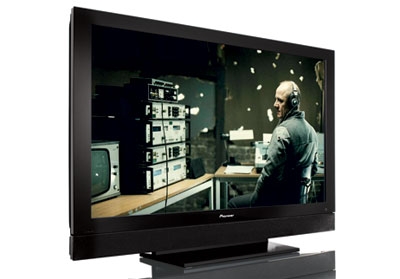Display-Tech Smackdown Page 2

Plasma
THE SCIENCE Employs an enormous array of tiny cells of ionized gas (plasma), which activates each cell's colored phosphor.
STRENGTHS Sabin: Plasma sales have been fading as of late against the LCD jauggernaut, but it's not due to lack of image quality. Of course, this has to be qualified: When I talk about plasma HDTVs these days, I refer primarily to those coming from Pioneer - a company whose current sets are so far above the competition, they clearly define the state of the art.
That said, Pioneer continues to vastly reduce - and promises now to eliminate - the aforementioned "idle brightness" that keeps plasmas from delivering totally black blacks. The most talked about demo at this year's CES, by far, was of Pioneer's prototype ultra-black panel offered as proof-of-concept, followed by the company's 9mm wafer-thin prototype. Pioneer says it will bring out TVs that combine both features, probably within a couple years. If they can, there may be life yet in this old dog, even in the face of OLEDs slow march to presumed dominance.
Trei: Plasma displays continue to define picture quality standards, especially when it comes to darker images and shadow detail. The best examples can deliver a sense of color accuracy and consistent screen brightness from corner to corner that LCDs have a hard time matching.
Griffin: As Sound & Vision's recent Plasma vs. LCD TV comparison test made clear, plasma still retains a distinct performance edge over LCD. Picture contrast, screen and grayscale uniformity, viewing angle - plasma TVs consistently rate better than LCD on all these key parameters. So for the foreseeable future, I will continue to nudge quality-conscious consumers seeking a new flat-panel set toward plasma.
WEAKNESSES Sabin: Heavy and power-hungry come to mind, though it remains to be seen if a super-thin plasma will still carry a big weight. And truth be told, image burn-in will always remain at least a mild concern with plasma TVs despite advances in this area.
Trei: Manufacturing a display with cells small enough to deliver the 1920 x 1080 "Full HD" resolution demanded by many specification-driven customers can be costly. Power consumption has been improving with each generation, but still lags behind LCD displays. Plasmas tend to look less punchy than LCDs in a brightly lit environment. For a given size, plasma sets are usually deeper and heavier than an LCD.
Griffin: While plasma offers a lot to satisfy demanding videophiles, those with more general viewing habits may find fault with the technology. Although the plasma "burn-in" issue has been seriously over-hyped by misguided sales folk, it's true you can potentially damage a plasma TV if you use it mostly to play videogames or continuously watch channels like Bloomberg TV (that are crammed with static onscreen graphics) with the contrast and brightness settings cranked up.
DOMINATION POTENTIAL Sabin: Today's best flat-panel images come from today's best plasmas, and it remains an evolving technology from which the best is yet to come. Unfortunately, though, recent plasma advances may simply be too little, too late. I won't fully discount it yet, but beyond the most demanding consumers willing to pay top prices, plasma is likely to cede the market to LCD.
Trei: Plasma continues to rule the roost in the 50-inch-and-up category, and remains the technology of choice for many videophiles. Early generation concerns regarding burn-in and panel life are now largely solved.
Griffin: When used in a controlled home theater environment, plasma delivers superior picture quality over competing flat-panel technologies. For the most part that's something that won't change dramatically. But unless plasma-makers manage to successfully reduce panel depth (Pioneer displayed a [3/4]-inch deep prototype model at the recent CES, indicating that progress is being made in that area), it may have a tough time going forward as new technologies like OLED shift into the big-screen TV marketplace.
- Log in or register to post comments



































































